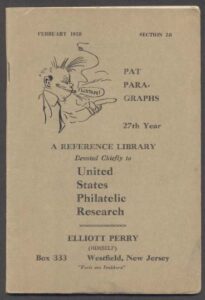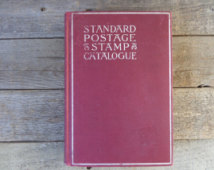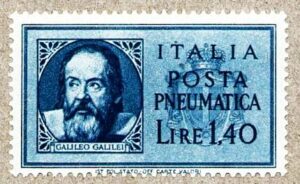 Elliot Perry may well have been the preeminent philatelist in an era that had some pretty good stamp scholars. Perry began his most famous series of articles in 1931. Entitled “Pat Paragraph”, these scholarly articles continued until the late 1950’s. Collected and republished in 1971 they run to over 650 pages of dense information and musings on classic US stamps and US Locals and Carriers. Perry’s work was one of the pinnacles of philatelic scholarship of the era. Perry himself was considered crusty and disputatious. Disagreements were, to him, personal insults. Arguments became holy crusades. But, without question, he was a devoted and conscientious scholar who greatly advanced the knowledge that we have about our stamps. Working from the effort of John N. Luff, the greatest scholar of the generation before him (whose classic work on US stamps was published in 1902), Perry used original sources to discuss printing methods and stamp usages and sales.
Elliot Perry may well have been the preeminent philatelist in an era that had some pretty good stamp scholars. Perry began his most famous series of articles in 1931. Entitled “Pat Paragraph”, these scholarly articles continued until the late 1950’s. Collected and republished in 1971 they run to over 650 pages of dense information and musings on classic US stamps and US Locals and Carriers. Perry’s work was one of the pinnacles of philatelic scholarship of the era. Perry himself was considered crusty and disputatious. Disagreements were, to him, personal insults. Arguments became holy crusades. But, without question, he was a devoted and conscientious scholar who greatly advanced the knowledge that we have about our stamps. Working from the effort of John N. Luff, the greatest scholar of the generation before him (whose classic work on US stamps was published in 1902), Perry used original sources to discuss printing methods and stamp usages and sales.
Serious philatelists often lament that the great days of stamp scholarship are behind us, that there are no Elliott Perry’s or Stanley Ashbrook’s or Carroll Chase’s anymore. This misses two essential points. First, the work that these great researchers did only needs to be done once. We don’t need to figure out again how to plate the one cent 1851. And we know the Brattleboro Postmaster Provisional print numbers because Perry found the records and published them. So to lament that scholarship is different today is simply to say that each generation of writers in a field builds on the work of others. But of far greater importance, I think, is the fact that Perry and the founding fathers of philately were writing for an entirely different era.


